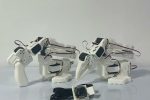AI and 3D printing from Hugging Face
U.S. tech company Hugging Face, in collaboration with French robotics developer The Robot Studio, robotics store WowRobo, robotics part seller PartaBot and Chinese IoT hardware supplier Seeed Studio, has unveiled the SO-ARM101—the latest addition to its open-source, 3D printable robotic arm series. Designed for hands-on experimentation in reinforcement learning and imitation learning, the SO-ARM101 is part of the broader SO-ARM10x platform, which includes the earlier SO-ARM100. The system integrates with Hugging Face’s LeRobot framework—a PyTorch-based toolkit for robotic AI development—and aims to provide a low-cost, accessible hardware option for AI research and training.
“Building on top of the insanely successful SO-100 (the most popular robot arms ever?), SO-101 are the first robot arms any AI builder should buy. It costs from $100 to $500 depending on how much you want it assembled and your country of shipping. Can’t wait to see what you all build with it. Let’s go open-source affordable AI robotics!,” said Clément Delangue, Co-founder & CEO, Hugging Face.
Key upgrades in the SO-ARM101 include a redesigned wiring system to prevent disconnection issues at joint 3, as well as mechanical changes that improve range of motion. The leader arm now uses motors with optimized gear ratios, eliminating the need for external gearboxes. Additionally, real-time synchronization between the leader and follower arms enables human-in-the-loop learning, allowing users to guide or adjust robot movements during training.
SO-ARM101 Robotic Arm. Photo via: Hugging Face.
Platform Features and Use Cases
The SO-ARM10x series is supported by a full suite of open-source resources, including assembly instructions, calibration tools, data collection guides, and deployment documentation. The arms are compatible with NVIDIA’s reComputer Mini J4012 Orin NX 16GB, making them suitable for edge-based AI training and on-device inference.
Through the LeRobot framework, users can simulate, train, and deploy models for physical tasks such as object manipulation, grasping, and placement. These workflows are intended to help users iterate quickly on AI model development in real-world settings. Community support is available via GitHub and Discord, where technical documentation and updates are maintained.
SO-ARM101 Arm Kit. Photo via: Seeed Studio.
System Overview and Technical Specifications
The SO-ARM101 shares its architecture with the earlier SO-ARM100 but includes targeted improvements for performance and reliability. The following table outlines key specifications:
FeatureSO-ARM100 Arm KitSO-ARM100 Arm Kit ProSO-ARM101 Arm KitSO-ARM101 Arm Kit ProLeader Arm Configuration12× 7.4V 1:345 gear ratio motors (all joints)12× 12V 1:345 gear ratio motors (all joints)1× 7.4V 1:345 motor (Joint No.2)2× 7.4V 1:191 motors (Joints No.1 & No.3)3× 7.4V 1:145 motors (Joints No.4, No.5 & gripper)1× 7.4V 1:345 motor (Joint No.2)2× 7.4V 1:191 motors (Joints No.1 & No.3)3× 7.4V 1:145 motors (Joints No.4, No.5 & gripper) Power Supply5.5mm×2.1mm DC 5V 4A5.5mm×2.1mm DC 12V 2A5.5mm×2.1mm DC 5V 4AFollower Arm: 5.5mm×2.1mm DC 12V 2ALeader Arm: 5.5mm×2.1mm DC 5V 4AAngle Sensor12-bit magnetic encoder12-bit magnetic encoder12-bit magnetic encoder12-bit magnetic encoderOperating Temperature0℃ – 40℃0℃ – 40℃0℃ – 40℃0℃ – 40℃Communication MethodUARTUARTUARTUARTControl MethodPCPCPCPC
The Rise of Open-Source 3D Printed Robots
In 2020, researchers at Intel Labs introduced the OpenBot, an open-source, 3D printed smart robot that can be built for under $50. Designed to work in tandem with a modern smartphone, OpenBot leverages the phone’s computing power to autonomously navigate and perform real-time sensing tasks—such as person-following and basic reconnaissance. By releasing the project as open source, Intel aims to empower a global community of tinkerers to push the boundaries of low-cost robotics.
In a similar spirit, researchers from the NYU Tandon School of Engineering and the Max Planck Institute for Intelligent Systems (MPI-IS) developed Solo 8, a fully open-source, 3D printed quadruped robot dog. Engineered to be both low-cost and scalable, Solo 8 offers robotics enthusiasts and educators an affordable entry point into legged locomotion research. Its modular construction allows users to build and experiment with their own robotic companion without the prohibitive costs typically associated with advanced robotic platforms.
Who won the 2024 3D Printing Industry Awards?
Subscribe to the 3D Printing Industry newsletter to keep up with the latest 3D printing news.You can also follow us on LinkedIn, and subscribe to the 3D Printing Industry Youtube channel to access more exclusive content.
Feature image shows SO-ARM101 Robotic Arm. Photo via: Hugging Face.


